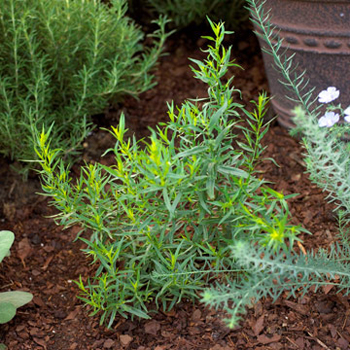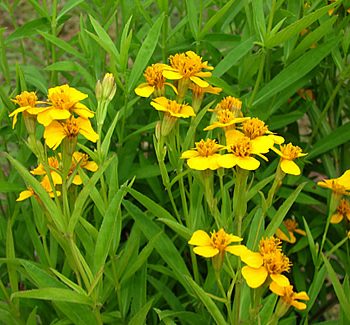Contents:
Common Names | Parts Usually Used | Plant(s) & Culture | Where Found | Medicinal Properties
Legends, Myths and Stories | Uses | Formulas or Dosages | How Sold | Warning | Bibliography
Scientific Names

- Artemisia dracunculus L.
- A. redowskii
- A. glauca var. draculina
- Compositae
- Composite family
Common Names
- Estragon
- Russian Tarragon
- Wild Tarragon
Parts Usually Used
The flowering plant; leaves and root
Back to Top

Description of Plant(s) and Culture
Tarragon is a green, glabrous perennial shrub; its branched root system with runners produces erect, bushy-branched stems from 2-4 feet high. The lower leaves are ternate, the upper leaves lanceolate to linear and small-toothed or entire. The small, drooping whitish-green or yellow flowers are almost globular and bloom from May to June in terminal panicles.
Back to Top
Where Found
Grows in sunny, dry areas in the western United States, southern Asia, and Siberia. In Europe it is cultivated for its leaves, which are used as a seasoning.
Back to Top
Medicinal Properties
Diuretic, emmenagogue, hypnotic, stomachic
Back to Top
Legends, Myths and Stories
Sometimes substituted for the cooking herb French Tarragon (A. dracunculus var. sativa), which, not producing viable seed, must be propagated vegetatively. The French Tarragon, also called little dragon (esdragon), smells strongly of anise; Wild Tarragon may be odorless and flavorless.
Tarragon traces its historic roots back hundreds of years before Christ. Its use was recorded by Greeks about 500 BC; tarragon was among the so-called “simples”, one-remedy herbs, used by Hippocrates. European gardeners knew tarragon in the Middle Ages, but it wasn’t until the end of those dark times that it leaped the English Channel. It entered England during the Tudor reign probably as a preferred gift for the royal herb garden from the Continental monarch. For many years, tarragon was relatively unknown outside the royal garden. It must eventually have made good its escape, because it arrived on America’s post-Revolutionary shores in the first few years of the 19th century.
The common name probably is a corruption of the French esdragon, derived from the plant’s Latin specific name dracunculus, a little dragon; p possibly so named because of its brown coiled roots resemblance to a cluster of small, gnarled serpents.
In ancient times, it was thought that tarragon could draw venom from bites of snakes and insects and in treating the bite off a mad dog (Rabies).
Tarragon has a licorice flavor that is both sweet and slightly bitter. One of the important herbs in French cooking; indispensable. in bearnaise sauce.
Tarragon adds zest to herbal combinations used to make liqueurs.
Do not mistake Artemisia dracunculus (Tarragon) with Artemisia absinthium (Wormwood) which is poisonous.
Back to Top
Uses
Relieves digestive problems and catarrhal difficulties, stimulates the action of the kidneys, and promotes the onset of menses. The tea stimulates the appetite, especially when it has been caused by illness. Taking the tea before retiring for the night helps overcome insomnia. Native Americans used leaf or root tea for colds, dysentery, diarrhea, headaches, difficult childbirth. Externally, leaves poulticed for wounds, bruises.
Back to Top
Formulas or Dosages
Infusion: steep 1/2 tsp. dried plant in 1/2 cup boiling water. Take 1/2 to 1 cup per day, unsweetened.
Back to Top
How Sold
As a spice in supermarkets
Back to Top
Warning
Do not mistake Artemisia dracunculus (Tarragon) with Artemisia absinthium
(Wormwood) which is poisonous.
Allergic reactions may result from use.
Back to Top
Bibliography
![]() Eastern/Central Medicinal Plants
Eastern/Central Medicinal Plants, by Steven Foster and James A. Duke., Houghton Mifflin Company, 215 Park Avenue South, New York, NY 10000
![]() The Herbalist Almanac
The Herbalist Almanac, by Clarence Meyer, Meyerbooks, publisher, PO Box 427, Glenwood, Illinois 60425, copyright 1988, fifth printing, 1994
![]() The Herb Book
The Herb Book, by John Lust, Bantam Books, 666 Fifth Avenue, New York, NY. copyright 1974.
Herbal Gardening, compiled by The Robison York State Herb Garden, Cornell Plantations, Matthaei Botanical Gardens of the University of Michigan, University of California Botanical Garden, Berkeley., Pantheon Books, Knopf Publishing Group, New York, 1994, first edition
 Old Ways Rediscovered
Old Ways Rediscovered, by Clarence Meyer, Meyerbooks, publisher, PO Box 427, Glenwood, Illinois 60425, published from 1954, print 1988
![]() Webster’s New World Dictionary
Webster’s New World Dictionary, Third College Edition, Victoria Neufeldt, Editor in Chief, New World Dictionaries: A Division of Simon & Schuster, Inc., 15 Columbus Circle, New York, NY 10023
![]() The Yoga of Herbs: An Ayurvedic Guide to Herbal Medicine
The Yoga of Herbs: An Ayurvedic Guide to Herbal Medicine, by Dr. David Frawley & Dr. Vasant Lad, Lotus Press, Twin Lakes, Wisconsin, Second edition, 1988.
 The Rodale Herb Book: How to Use, Grow, and Buy Nature’s Miracle Plants (An Organic gardening and farming book)
The Rodale Herb Book: How to Use, Grow, and Buy Nature’s Miracle Plants (An Organic gardening and farming book), edited by William H. Hylton, Rodale Press, Inc. Emmaus, PA, 18049., 1974
